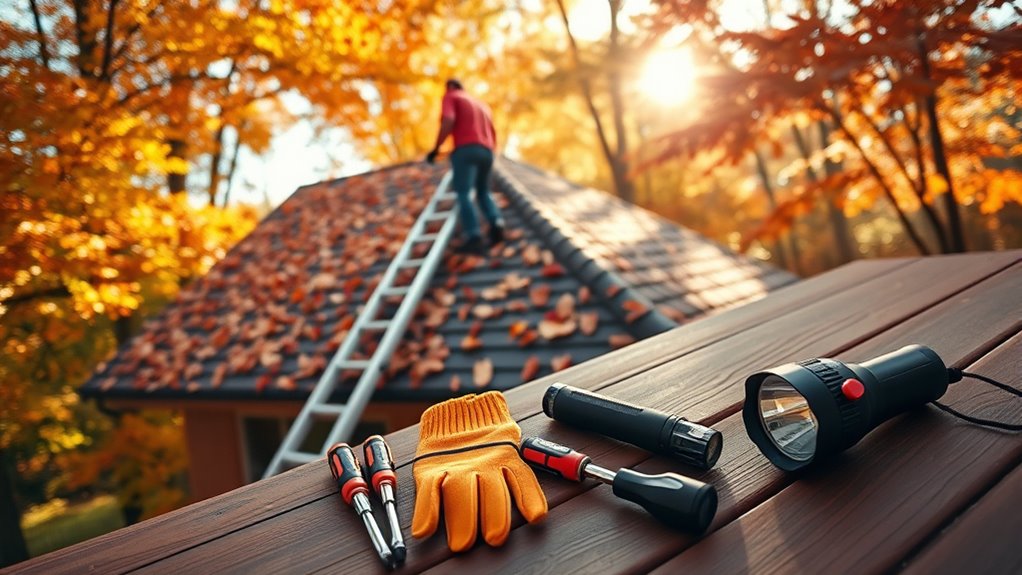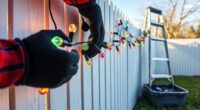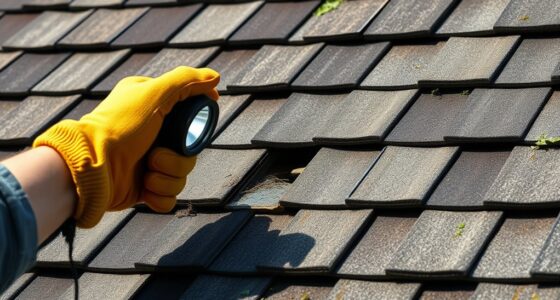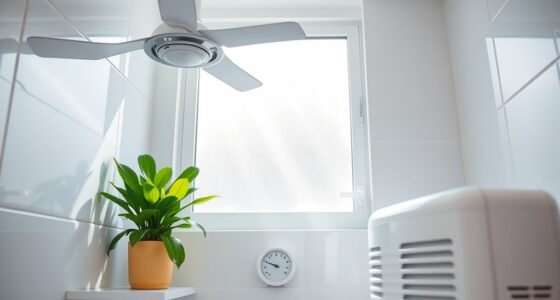To save money this fall, prioritize preparing your home for winter by inspecting and sealing gaps around windows and doors to prevent heat loss. Replace filters regularly, schedule HVAC tune-ups, and consider a programmable thermostat to reduce energy use. Clean gutters, inspect your roof for damage, and clear debris to prevent costly repairs. Confirm safety devices work properly and keep fire safety equipment accessible. Keep exploring tips that can help you maintain your home efficiently and save more.
Key Takeaways
- Regularly replace or clean air filters to improve HVAC efficiency and lower energy bills.
- Seal leaks around windows and doors to prevent heat loss and reduce heating costs.
- Schedule chimney and fireplace inspections to ensure safe operation and avoid costly repairs.
- Clean gutters and inspect the roof for damage to prevent water leaks and costly repairs.
- Insulate pipes and attic spaces to prevent freezing and costly emergency repairs during winter.
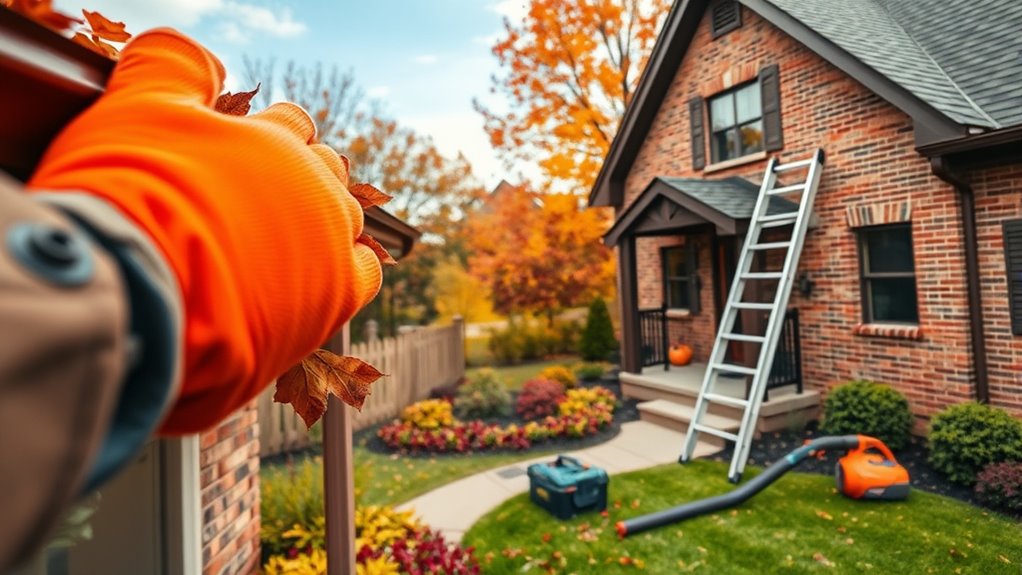
As fall approaches, preparing your home for the colder months ahead is vital. Taking the time to maintain your heating system now can save you considerable money on energy bills later. Start by changing the air filter in your furnace and checking its efficiency. A clean filter improves airflow and heating performance, reducing energy consumption. It’s wise to stock up on extra filters now and change them monthly throughout the winter. Additionally, hiring an HVAC contractor to test your heating output and tune up your system guarantees it runs at peak efficiency when you need it most. Consider installing a programmable thermostat; it allows you to lower the temperature when you’re not home or asleep, cutting down on unnecessary energy use and lowering your utility bills. While inspecting your heating system, don’t forget to check your ducts and vents. Clearing any blockages and ensuring they’re sealed tight prevents heat loss, making your system more effective and saving you money. Regular maintenance of your HVAC system also helps extend its lifespan and reduces the likelihood of costly repairs.
Prepare your home for winter by maintaining your heating system and sealing drafts to save energy and reduce bills.
Next, inspect your fireplaces and chimneys. Make sure your woodstoves and fireplaces are clean and functional before lighting that first fire of the season. It’s essential to clean chimneys annually to prevent dangerous creosote buildup that can cause fires. Double-check that your chimney’s ventilation is proper and look for any blockages or damage, which could lead to smoke or carbon monoxide leaks. Hiring a professional for chimney cleaning is a good idea if you’re unsure.
For your safety, test smoke and carbon monoxide alarms monthly. Replace batteries annually or as needed to guarantee they operate correctly. Fire extinguishers should be accessible and in good condition. Conduct a home safety inspection to identify potential hazards, like loose handrails or exposed wiring. Installing emergency lighting in key areas adds an extra layer of security in case of power outages during storms.
Roof and gutter maintenance also helps you save money. Inspect your roof for missing or damaged shingles that could cause leaks. Clean out gutters and downspouts to prevent water damage and consider installing gutter guards to reduce clogs. Look for signs of water damage or leaks around your home’s exterior and hire a professional for a thorough roof inspection if necessary. Regular roof inspections can also help identify issues early before they turn into costly repairs.
Sealing drafts around windows and doors can greatly improve your home’s insulation. Use weatherstripping and caulk to seal gaps, and check attic insulation to ensure it’s sufficient. Adding insulation in under-insulated areas keeps warm air in and cold air out, reducing heating costs. Proper insulation and energy efficiency measures are key to lowering your home’s overall energy consumption.
Finally, prepare your yard and exterior for winter. Trim tree branches that could damage your home in storms, clear leaves and debris, and protect plants from frost. Secure outdoor furniture and check fences for stability. Insulate exposed pipes in unheated areas to prevent freezing, and drain hoses to avoid burst pipes. Insulating your water heater and installing freeze-proof outdoor faucets also help you avoid costly repairs. Taking these steps now guarantees your home is safe, efficient, and ready for winter, saving you money and stress in the long run.
Frequently Asked Questions
When Is the Best Time to Service My Furnace in Fall?
The best time to service your furnace in fall is early before temperatures drop considerably. You want to schedule maintenance before cold weather hits, so your furnace is ready when needed. This prevents emergency breakdowns, improves energy efficiency, and ensures comfort throughout winter. Booking your appointment early also helps avoid the busy season rush, giving technicians ample time to check, clean, and repair any issues for a reliable heating season ahead.
How Do I Identify Leaks Before Winter Arrives?
To identify leaks before winter, start by inspecting pipes and fittings for signs of damage or wear. Use moisture meters or thermal imaging cameras to detect hidden leaks or moisture issues. Check your water meter for unexplained increases, which can signal leaks. Conduct dye tests in toilets or fixtures, and listen for hissing sounds with acoustic listening devices. Addressing these early helps prevent costly damage when freezing temperatures arrive.
What Are Affordable Ways to Insulate Windows?
You can insulate your windows affordably by applying plastic film or bubble wrap with heavy-duty tape. Use a hairdryer to shrink plastic film tightly, or spray water on bubble wrap before pressing it onto the glass for better adhesion. Weatherstripping and sealing gaps with caulk also help. These methods are budget-friendly and effective, reducing drafts and keeping your home warmer without spending much.
How Often Should Gutters Be Cleaned in Fall?
You should clean your gutters at least twice during fall, ideally after most leaves have fallen and again before winter hits. In areas with lots of trees, three cleanings might be necessary—spaced in late October, November, and just before winter. Regular inspections after storms can help catch heavy debris buildup early. Staying proactive guarantees your gutters function properly, preventing water damage and ice dam formation during colder months.
Are There Eco-Friendly Options for Fall Pest Control?
Imagine your home surrounded by falling leaves, a perfect scene for pests to sneak in. You can keep them out naturally using eco-friendly methods like sealing cracks, installing door sweeps, and placing traps. You might also spray essential oils or neem oil, encourage beneficial insects, or use physical barriers like row covers. These strategies protect your home while preserving the environment, making fall pest control safe and effective without harmful chemicals.
Conclusion
By tackling these fall home maintenance tips, you’ll keep your home cozy and save money, just like a squirrel stockpiling acorns for winter. Regular upkeep now prevents costly repairs later, making your home a safe, comfortable haven. Embrace these simple tasks with enthusiasm—you’ll enjoy peace of mind all season long. Remember, a well-maintained home is like a well-tended garden: it flourishes and rewards you in many ways. Stay proactive, and your home will thank you!

